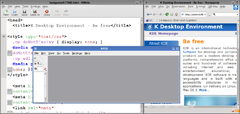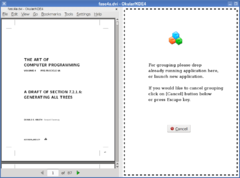Projects/Usability/NWI
This is summary-in-progress, thus there are question notes in the text.
From editor :-) -- how to add [edit] buttons per each section/heading?
The idea of NWI (Nested Windows Interface) emerged from the discussion about MDI (Multiple Document Interface) — so far each application had to implement the most suitable UI by its own (TDI in Konqueror, SDI in Okular) which led to inconsistent behaviour ("is closing the last document possible?"). NWI is thought as uniform UI at one hand, while help to increase productivity by extending the idea of tiles and tabs on the other.
Why?
It happens almost every day — you edit some data in one application (like html file in KWrite), you view the results using another application (like Konqueror). So despite there is no relation between KWrite and Konqueror, for this task — task you perform right now — those two applications are related. Would it be useful if those two applications work temporarily as one — a group?

Let's say you launched Kpdf as well. Traditionally when you switch from Kpdf to KWrite, Window Manager (WM) brings only KWrite to the front, so you have to bring to front Konqueror by yourself. This tiresome — with grouping, KWrite and Konqueror would act as one — you switch to group, all applications are put in front.
Whenever you feel it would be more natural to put several applications as one group (because of the common task, or common data, or just for fun), NWI lets you do it — as tiles or as tabs.
What is it?
Probably you are already familiar with several User Interface kinds — TDI, MDI, SDI, and so on. Some of them proved to be very useful, some of them not especially. In NWI world the most basic, yet the more flexible UI you can think of are SAI, GAI and TAI.
Single Application Interface (SAI)
This is really the simplest UI, no magic here. Just application window with some data — if application window can hold only one document per window, it is SAI. Examples: Kpdf, Okular.

Floating Application Interface (FAI)
The most common FAI container is desktop — you can tell whether container is FAI if the embedded windows can be moved in such way they overlap. Despite KDE desktop runs by default in FAI mode it is possible to switch it to another type.
Can we have non-root FAI containers? maciej — yes, it helps reorganizing GAI
Grouped Applications Interface (GAI)
More accurate name would be Tiling Applications Interface, but such name would conflict with Tabbed Applications Interface.
GAI is such container that tiles selected windows, so they are close together, next to each other — vertically or/and horizontally. From geometrical point of view GAI container behaves as one window with many panes.
GAI has one shared titlebar (for container) plus at user request mini-titlebar for each window embedded into GAI. By default each application menu stays within its pane but it is possible to configure it so the one menu is displayed per whole container — menu of the active application pane.
When you finish grouping, you still can change the proportions of the group "panes" just like in KMail for example. You can also rearrange them — via context menu or simply by like dragging docked windows.
Tabbed Applications Interface (TAI)
You know the special case of TAI already — it is TDI (Tabbed Document Interface). The well-known example of TDI application is Konqueror. You can launch one Konqueror and then open multiple web pages, each per one tab.
TAI goes a little further — you can arrange several applications in tabs and put them into one window. So in one tab you can have Konqueror displaying web page, and in the second tab you can have Okular displaying pdf file.
Nested Windows Interface (NWI)
Once the container is arranged, you can think of it as a window. And such window you can put into another container — thus nesting containers. So in general, such UI is called NWI, Nested Windows Interface.
Features
Session management
When you turn the session management on (at KDE level), SM not only restores the applications, but also recreates grouping.
It is also possible to save container state as preset (like: Kwrite+Konqueror) and then later launch such group at once — without recreating the group manually.
Taskbar presentation
Taskbar shows the first-class windows — i.e. windows that are not embedded into any containers. When user clicks LMB on container entry in the taskbar, the list of all embedded applications is shown.
Actions
Managing the containers
Except for the root container (the desktop) empty containers are not allowed. Thus you have to point out which windows you would like to group or convert one of the windows to be container and add another window to it.
Arranging windows as container
- launch applications as you like
- RMB on the desktop to get context menu
- choose "select windows"
- select desired windows
- RMB on the desktop to get context menu again
- choose "group selection" — container is created
To select windows:
- with Shift+LMB pressed down select region over the windows (like in KSnapshot)
- with Ctrl pressed down click LMB on the window (to deselect click again)
Picker for easier selecting? Maybe none, but allowing to run switchers?
Incremental adding

Disassembling the container
- user can convert any container to any other type (for example FAI to GAI)
- user can tear off any window from the container to other container, even if the source and target containers are different types (tear off by d&d or explicit RMB and choosing "ungroup"?)
